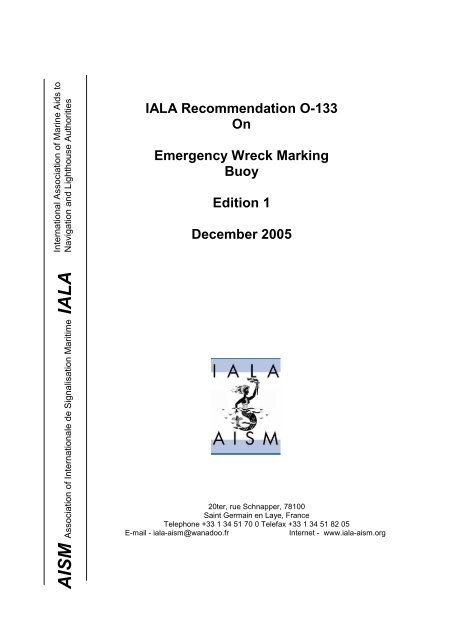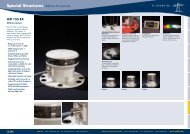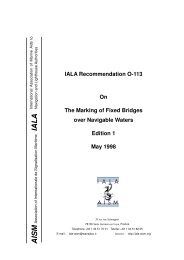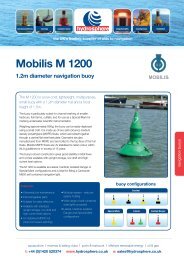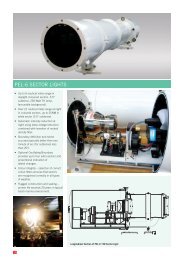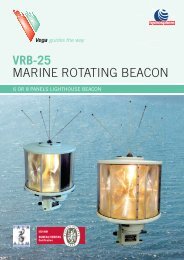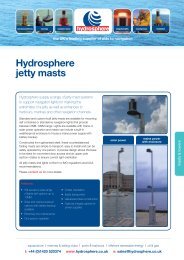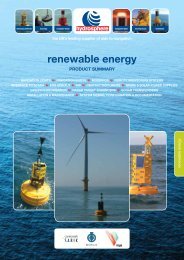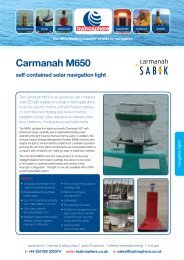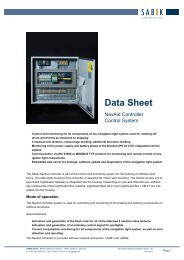IALA Recommendation O-133 on the Emergency Wreck Marking Buoy
IALA Recommendation O-133 on the Emergency Wreck Marking Buoy
IALA Recommendation O-133 on the Emergency Wreck Marking Buoy
Create successful ePaper yourself
Turn your PDF publications into a flip-book with our unique Google optimized e-Paper software.
Internati<strong>on</strong>al Associati<strong>on</strong> of Marine Aids to<br />
Navigati<strong>on</strong> and Lighthouse Authorities<br />
AISM Associati<strong>on</strong> of Internati<strong>on</strong>ale de Signalisati<strong>on</strong> Maritime <str<strong>on</strong>g>IALA</str<strong>on</strong>g><br />
<str<strong>on</strong>g>IALA</str<strong>on</strong>g> <str<strong>on</strong>g>Recommendati<strong>on</strong></str<strong>on</strong>g> O-<str<strong>on</strong>g>133</str<strong>on</strong>g><br />
On<br />
<strong>Emergency</strong> <strong>Wreck</strong> <strong>Marking</strong><br />
<strong>Buoy</strong><br />
Editi<strong>on</strong> 1<br />
December 2005<br />
20ter, rue Schnapper, 78100<br />
Saint Germain en Laye, France<br />
Teleph<strong>on</strong>e +33 1 34 51 70 0 Telefax +33 1 34 51 82 05<br />
E-mail - iala-aism@wanadoo.fr Internet - www.iala-aism.org
<str<strong>on</strong>g>IALA</str<strong>on</strong>g> <str<strong>on</strong>g>Recommendati<strong>on</strong></str<strong>on</strong>g> O-<str<strong>on</strong>g>133</str<strong>on</strong>g> <strong>on</strong> <strong>the</strong> <strong>Emergency</strong> <strong>Wreck</strong> <strong>Marking</strong> <strong>Buoy</strong><br />
Editi<strong>on</strong> 1, December 2005<br />
<str<strong>on</strong>g>IALA</str<strong>on</strong>g> <str<strong>on</strong>g>Recommendati<strong>on</strong></str<strong>on</strong>g> <strong>on</strong> <strong>Emergency</strong> <strong>Wreck</strong> <strong>Marking</strong><br />
<strong>Buoy</strong><br />
THE COUNCIL:<br />
<str<strong>on</strong>g>Recommendati<strong>on</strong></str<strong>on</strong>g> O-<str<strong>on</strong>g>133</str<strong>on</strong>g><br />
NOTING <strong>the</strong> functi<strong>on</strong> of <str<strong>on</strong>g>IALA</str<strong>on</strong>g> with respect to <strong>the</strong> safety of marine<br />
navigati<strong>on</strong>, <strong>the</strong> efficiency of maritime transport and <strong>the</strong><br />
protecti<strong>on</strong> of <strong>the</strong> envir<strong>on</strong>ment;<br />
NOTING ALSO <strong>the</strong> provisi<strong>on</strong>s c<strong>on</strong>tained within <strong>the</strong> <str<strong>on</strong>g>IALA</str<strong>on</strong>g> Maritime<br />
<strong>Buoy</strong>age System (MBS), and related <str<strong>on</strong>g>IALA</str<strong>on</strong>g> <str<strong>on</strong>g>Recommendati<strong>on</strong></str<strong>on</strong>g>s<br />
and <str<strong>on</strong>g>IALA</str<strong>on</strong>g> Guidelines;<br />
RECOGNISING <strong>the</strong> significant hazard to shipping posed by new<br />
wrecks or obstructi<strong>on</strong>s;<br />
RECOGNISING ALSO that it is a matter for a Nati<strong>on</strong>al Authority to<br />
assess <strong>the</strong> danger to shipping, navigati<strong>on</strong>al requirement, <strong>the</strong><br />
risk involved, and to decide <strong>on</strong> emergency wreck marking;<br />
RECOGNISING FURTHER that emergency marking of dangerous<br />
wrecks is intended to preserve <strong>the</strong> safety of life, safety of<br />
navigati<strong>on</strong> and to protect <strong>the</strong> marine envir<strong>on</strong>ment;<br />
HAVING CONSIDERED <strong>the</strong> proposals by <strong>the</strong> <str<strong>on</strong>g>IALA</str<strong>on</strong>g> Aids to Navigati<strong>on</strong><br />
Management Committee and taking into account <str<strong>on</strong>g>IALA</str<strong>on</strong>g><br />
Guideline No. 1046 Resp<strong>on</strong>se Plan for <strong>the</strong> <strong>Marking</strong> of New<br />
<strong>Wreck</strong>s;<br />
ADOPTS <strong>the</strong> “<strong>Emergency</strong> <strong>Wreck</strong> <strong>Marking</strong> <strong>Buoy</strong>”, set out in <strong>the</strong> Annex<br />
to this <str<strong>on</strong>g>Recommendati<strong>on</strong></str<strong>on</strong>g>, for use <strong>on</strong> a trial basis; and<br />
RECOMMENDS that Resp<strong>on</strong>sible Authorities, in additi<strong>on</strong> to <strong>the</strong> use of<br />
<strong>the</strong> MBS and in c<strong>on</strong>juncti<strong>on</strong> with o<strong>the</strong>r measures, c<strong>on</strong>sider <strong>the</strong><br />
deployment of <strong>Emergency</strong> <strong>Wreck</strong> <strong>Marking</strong> <strong>Buoy</strong>s, as described<br />
in <strong>the</strong> Annex to this <str<strong>on</strong>g>Recommendati<strong>on</strong></str<strong>on</strong>g>.<br />
* * * * * *<br />
Page 2 of 4
1 INTRODUCTION<br />
<str<strong>on</strong>g>IALA</str<strong>on</strong>g> <str<strong>on</strong>g>Recommendati<strong>on</strong></str<strong>on</strong>g> O-<str<strong>on</strong>g>133</str<strong>on</strong>g> <strong>on</strong> <strong>the</strong> <strong>Emergency</strong> <strong>Wreck</strong> <strong>Marking</strong> <strong>Buoy</strong><br />
Editi<strong>on</strong> 1, December 2005<br />
ANNEX – <strong>Emergency</strong> <strong>Wreck</strong> <strong>Marking</strong> <strong>Buoy</strong><br />
The wreck of <strong>the</strong> ‘Tricolor’ in <strong>the</strong> Dover Straits in 2002 has brought into sharp focus <strong>the</strong><br />
effective resp<strong>on</strong>ses required to adequately and quickly mark such new dangers and prevent<br />
collisi<strong>on</strong>s. Resp<strong>on</strong>sible Authorities need to assess <strong>the</strong>ir areas of resp<strong>on</strong>sibility and rapid<br />
resp<strong>on</strong>se capability as part of <strong>the</strong>ir c<strong>on</strong>tingency planning.<br />
The <str<strong>on</strong>g>IALA</str<strong>on</strong>g> Guideline No.1046 - Resp<strong>on</strong>se Plan for <strong>the</strong> <strong>Marking</strong> of New <strong>Wreck</strong>s (June<br />
2005) provides guidance to Authorities for an immediate, effective and well co-ordinated<br />
resp<strong>on</strong>se in such a situati<strong>on</strong>. The guidelines recommend procedures to be observed, as well<br />
as c<strong>on</strong>siderati<strong>on</strong>s to be taken into account with respect to all necessary measures when<br />
c<strong>on</strong>fr<strong>on</strong>ted with a new danger or an obstructi<strong>on</strong> as a result of an incident within <strong>the</strong>ir area of<br />
resp<strong>on</strong>sibility.<br />
Fur<strong>the</strong>rmore, <strong>the</strong>re has been discussi<strong>on</strong> with regards to <strong>the</strong> limitati<strong>on</strong>s of <strong>the</strong> present <str<strong>on</strong>g>IALA</str<strong>on</strong>g><br />
Maritime <strong>Buoy</strong>age System when providing initial marking of new dangers. At present, new<br />
dangers are generally marked by cardinal or lateral buoys, although it is recognised that a<br />
number of Authorities also deploy isolated danger marks. Recent groundings and collisi<strong>on</strong>s<br />
have indicated a need for a revisi<strong>on</strong> of how new dangers are to be marked, especially in an<br />
emergency. As such, Guideline No. 1046 provides guidance and recommendati<strong>on</strong>s for<br />
emergency wreck marking.<br />
2 SCOPE & OBJECTIVES<br />
Within <strong>the</strong> Guideline, reference is made to an ‘emergency wreck marking buoy’. This<br />
<str<strong>on</strong>g>Recommendati<strong>on</strong></str<strong>on</strong>g> provides details of a new buoy c<strong>on</strong>figurati<strong>on</strong>, in additi<strong>on</strong> to that already<br />
found in <strong>the</strong> <str<strong>on</strong>g>IALA</str<strong>on</strong>g> Maritime <strong>Buoy</strong>age System, which Authorities may c<strong>on</strong>sider deploying<br />
when resp<strong>on</strong>ding to a new danger or obstructi<strong>on</strong>.<br />
3 CONSIDERATIONS<br />
A new wreck can be very dangerous for shipping, not <strong>on</strong>ly when its exact positi<strong>on</strong> is<br />
unknown and is still unmarked, but even when <strong>the</strong> positi<strong>on</strong> is known and <strong>the</strong> wreck is<br />
properly marked. In <strong>the</strong> past, new wrecks have caused problems to o<strong>the</strong>r shipping resulting<br />
in damage, polluti<strong>on</strong> and even loss of life. As detailed in <strong>the</strong> Guideline No.1046, Authorities<br />
should c<strong>on</strong>sider a range of resp<strong>on</strong>ses including <strong>the</strong> deployment of guardships, <strong>the</strong> use of AIS,<br />
temporary VTS and deployment of buoys am<strong>on</strong>gst o<strong>the</strong>r risk mitigati<strong>on</strong> measures.<br />
Whatever additi<strong>on</strong>al risk mitigati<strong>on</strong> measures are initiated, a new danger must be physically<br />
marked. Wea<strong>the</strong>r c<strong>on</strong>diti<strong>on</strong>s, sea state and unknown facts about <strong>the</strong> danger can all hamper<br />
timely marking. However, it is of great importance that <strong>the</strong> locati<strong>on</strong> of <strong>the</strong> danger is marked<br />
as so<strong>on</strong> as practicable and that this marking can be readily recognised by ships as a new<br />
hazard.<br />
The volume of traffic, background lighting and proliferati<strong>on</strong> of Aids to Navigati<strong>on</strong> (AtoN) in<br />
<strong>the</strong> area may make <strong>the</strong> deployment of cardinal or lateral marks difficult for mariners to<br />
quickly identify a new danger in <strong>the</strong> initial stages of an incident. In <strong>the</strong>se instances,<br />
Authorities are invited to c<strong>on</strong>sider <strong>the</strong> deployment of an emergency wreck marking buoy that<br />
is specifically designed to mark new dangers.<br />
Page 3 of 4
<str<strong>on</strong>g>IALA</str<strong>on</strong>g> <str<strong>on</strong>g>Recommendati<strong>on</strong></str<strong>on</strong>g> O-<str<strong>on</strong>g>133</str<strong>on</strong>g> <strong>on</strong> <strong>the</strong> <strong>Emergency</strong> <strong>Wreck</strong> <strong>Marking</strong> <strong>Buoy</strong><br />
Editi<strong>on</strong> 1, December 2005<br />
4 EMERGENCY WRECK MARKING BUOY<br />
The emergency wreck-marking buoy is designed to provide high visual and radio aid to<br />
navigati<strong>on</strong> recogniti<strong>on</strong>. It should be placed as close to <strong>the</strong> wreck as possible, or in a pattern<br />
around <strong>the</strong> wreck, and within any o<strong>the</strong>r marks that may be subsequently deployed.<br />
The emergency wreck marking buoy should be maintained in positi<strong>on</strong> until:<br />
• The wreck is well known and has been promulgated in nautical publicati<strong>on</strong>s;<br />
• The wreck has been fully surveyed and exact details such as positi<strong>on</strong> and least depth<br />
above <strong>the</strong> wreck are known;<br />
• A permanent form of marking of <strong>the</strong> wreck has been carried out.<br />
4.1 Characteristics<br />
The buoy has <strong>the</strong> following characteristics:<br />
• A pillar or spar buoy, with size dependant <strong>on</strong> locati<strong>on</strong>.<br />
• Coloured in equal number and dimensi<strong>on</strong>s of blue and yellow vertical stripes (minimum<br />
of 4 stripes and maximum of 8 stripes).<br />
• Fitted with an alternating blue* and yellow flashing light with a nominal range of 4<br />
nautical miles (authorities may wish to alter <strong>the</strong> range depending <strong>on</strong> local c<strong>on</strong>diti<strong>on</strong>s)<br />
where <strong>the</strong> blue and yellow 1 sec<strong>on</strong>d flashes are alternated with an interval of 0.5 sec<strong>on</strong>ds.<br />
Bu1.0s + 0.5s + Y1.0s + 0.5s = 3.0s<br />
• If multiple buoys are deployed <strong>the</strong>n <strong>the</strong> lights should be synchr<strong>on</strong>ised.<br />
• C<strong>on</strong>siderati<strong>on</strong> should be given to <strong>the</strong> use of a rac<strong>on</strong> Morse Code “D” and/or AIS<br />
transp<strong>on</strong>der.<br />
• The top mark, if fitted, is to be a standing/upright yellow cross.<br />
*The light characteristic was chosen to eliminate c<strong>on</strong>fusi<strong>on</strong> with blue lights to identify law<br />
enforcement, security and emergency services.<br />
Page 4 of 4


